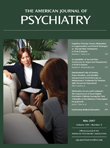Oxcarbazepine in Youths With Autistic Disorder and Significant Disruptive Behaviors
To The Editor: Disruptive behaviors are a frequent reason for psychiatric visits among autistic individuals. The following case report describes beneficial effects in three consecutive oxcarbazepine-treated autistic youths with disruptive behaviors. All three patients had been conjointly engaged in behavioral therapies provided by local treatment facilities.
“A.B.” is a 13-year-old Hispanic male with frequent aggression toward others and property, irregular sleep, and poor ability to follow instructions. Previous effective trials of risperidone and olanzapine were both discontinued because of elevated liver transaminases and excessive weight gain, respectively. Oxcarbazepine was titrated to 300 mg every morning and 600 mg every night over 7 days. Two weeks later, the patient’s mother reported improved compliance at home, and school reports showed improved cooperation and attention span. The aggression was decreased in severity and frequency, and regular sleep was established. He has been stable on this regimen for 4 months.
“C.D.” is a 19-year-old Caucasian female with dysfunctional compulsive routines, head banging, and frequent violent outbursts. Fluoxetine was titrated to 20 mg daily over 2 months. The compulsive symptoms improved dramatically, but she remained aggressive. Risperidone augmentation failed, so oxcarbazepine was titrated to 600 mg b.i.d. One month later, her tantrums were significantly reduced, and cooperativeness improved. The head banging was reduced from more than 10 spells per day to approximately once per week. The patient has been on this combination of fluoxetine and oxcarbazepine for 6 months.
“E.F.” is a 4½-year-old Hispanic child whose symptoms included head banging, property destruction, hitting others, irregular sleep, and hyperactivity. Previous treatments with methylphenidate and amphetamine salts resulted in agitation; trials of guanfacine and risperidone failed. Oxcarbazepine was titrated to 150 mg every morning and 300 mg every night over 2½ months, resulting in normalized sleep schedule, improved cooperativeness, and lessened aggression. The patient has been maintaining these improvements for 3½ months.
Written informed consent was obtained from the legal guardians in all three cases. None of the patients have developed hyponatremia or other untoward outcomes.
To our knowledge, this is the first report of oxcarbazepine use in autism with disruptive behaviors. These symptoms are best managed by combining behavior modification and psychotropic agents (1) . While haloperidol and risperidone have solid evidence base supporting their efficacy and effectiveness in this indication, their side-effect profiles (i.e., extrapyramidal symptoms and weight gain, respectively) are equally well documented (2) . Controlled trials also support fluoxetine and fluvoxamine, but treatment-emergent behavioral activation (3) limits their clinical applicability. Oxcarbazepine has a more favorable side-effect profile, and it is available in liquid form, which is often more convenient for autistic patients. Hopefully, this report will inspire future research on the effects of oxcarbazepine in autistic individuals.
1. Volkmar F, Cook EH Jr, Pomeroy J, Realmuto G, Tanguay P: Practice parameters for the assessment and treatment of children, adolescents, and adults with autism and other pervasive developmental disorders. J Am Acad Child Adolesc Psychiatry 1999; 38(suppl 12):32S–54SGoogle Scholar
2. Kapetanovic S, Simpson GM: Review of antipsychotics in children and adolescents. Expert Opin Pharmacother 2006; 7:1871–1885Google Scholar
3. King BH, Bostic JQ: An update on pharmacologic treatments for autism spectrum disorders. Child Adolesc Psychiatr Clin N Am 2006; 15:161–175Google Scholar



